On November 30, CNCHnet published a notice about “Our First Study Group” in which CNCH and member guilds embarked on a new adventure. This adventure opened up the possibilities for individual guild study groups to expand their participating members to persons outside of their immediate guild who belonged to another CNCH guild.
Reno Fiber Guild (RFG) took the plunge and awakened a study group started some ten years earlier that had woven drafts from The Weavers Draft and Clothiers Assistant, published by John Hargrove in 1792. This publication is thought to be the very first of its kind in both colonial and post revolution America.
The Hargrove book was published in order that weaving drafts could be more widely shared among weavers in the newly formed country. John Hargrove was concerned that weavers were not sharing their drafts or their knowledge with one another. He set about to correct this by collecting 52 drafts and publishing them. Over two hundred years later, we follow his lead and will freely share what we learn from this book and how the drafts might be utilized in contemporary ways.
There are currently 23 members in this study. Some have elected to weave samples and do research on their own and some have joined a sample exchange group. We share our experiences in Reno at Sage Weavers meetings, the Reno Fiber Guild Blog and on a Yahoo group that was set up for study group communications. The group is still open to anyone belonging to a CNCH guild.
When I set out to write this article, I thought that the very best way to communicate our progress and how it functions would be to have several different members tell the story of their own journey.
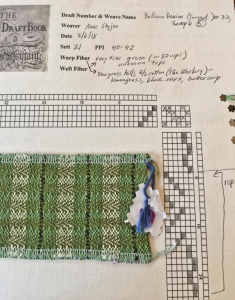
Balloon cord sample
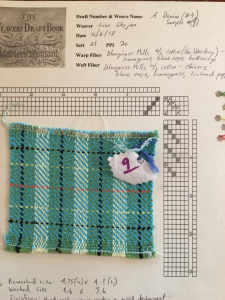
Denim Sample
As a relatively new weaver, I have approached the Hargrove study as an opportunity to improve my weaving skills generally. So far, I have prepared about half of the Hargrove drafts that can be woven on a 4-shaft loom. I plan to continue working through the remaining drafts, and may revisit some of those I have already done to try different warps and different setts.
My process: I have been setting up approximately 5” wide warps of about 5 yards long. To date I have set up 2 warps. The first was 8/4 cotton carpet warp at 18 epi, and the second 6/2 cotton at 21 and 18 epi. For weft, I select from an eclectic assortment of contemporary and vintage wool and cotton yarns, and handspun wool yarns. These include 8/4 cotton carpet warp, 8/2 cotton, handspun 2-ply and singles, lambswool, 50 ppi synthetic thread (of unknown type), and various other yarns. On each warp, I work a series of samples that work with the given threading, varying the tie up as necessary. In some cases, I have cut the samples from the loom and rethreaded the heddles to work another Hargrove pattern
After weaving a sample (usually 4-6 inches long), I weave a couple of shots of a contrast thread and then start the next sample. After I cut the samples from the loom, I zig zag stitch and cut or serge between samples, measure each sample, attach a Tyvek tag (made from cut squares of recycled Tyvek envelopes) on which I write the sample number, wash, dry and press each sample, and re-measure to determine shrinkage. For the best samples, I prepare a sample card on 8 ½ X 11 cardstock to document warp, weft, sett, ppi, threading, treadling, tie up, finishing method, and shrinkage. I attach the woven sample to the card using double stick tape. Finally, I punch holes on the side of the card and attach samples of the yarn used to weave the sample.
I have already learned a tremendous amount from the work I have done in the study group. It’s been great experience for me to develop good record keeping practices and learn more about yarns I already own. Since I have a 4-shaft loom, I learned to turn drafts; this gave me the option of weaving some of the patterns that are written for more than four shafts. Additionally, I have become fairly comfortable reading vintage drafts and converting them to a more modern style of draft. As part of my work in the group, I also learned to use weaving software for the first time.
Although the individual samples I have made are small, they are fascinating to examine for helping me understand how sett and yarn type impact fabric woven from a given draft. They may be useful starting points to develop patterns for items such as towels, placemats and napkins, and possibly also larger pieces of fabric to be sewn up as shirts, jackets, or other items.
Hargrove provides in his preface what appears to be recommended yarns and setts for the various drafts. For example, he describes at least the fiber type (cotton or linen, for example) and appears to reference recommended sett in relation to the sett of linen (“Most of them may be sleyed as high as Linen…”). Maybe in those days the options for cotton and linen yarn were relatively limited so that there was no need to explain further. Without knowing much about the yarns and weaving styles of those days, reproducing the Hargrove drafts with historical accuracy is not really possible. However, for me this really is unnecessary. While I am interested in the Hargrove drafts from a historical perspective, and I enjoy feeling connected in this way to colonial America, it feels completely appropriate, and in some ways a form of tribute, to explore the potential in these drafts using the immense range of materials at our disposal today.
Many of the samples I have woven seem very sturdy and utilitarian, particularly given the yarns and setts I have chosen so far. It will be interesting to see how the same patterns appear when woven with finer yarns. My favorites so far are the samples woven from drafts for Dimity, The Irish Fancy, Balloon Denim (particularly with fine weft), and Denim.
Anne Shyjan, Grass Valley, CA
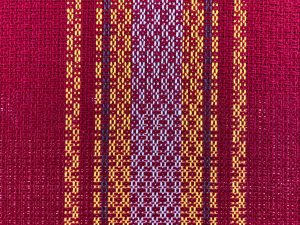
Ducape
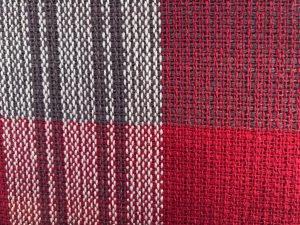
Ducape reverse side
(Insert photo 3 & 4 from Kathy Rand. Photo 3 is the face cloth of Ducape and Photo 4 is the underside of the same cloth as it is being woven on the loom)
This sample is Ducape #14 in Hargrove’s book. According to Merriam Webster the definition is a heavy corded silk dress fabric popular chiefly in the 18th century. In Hargrove’s notation, the treadling is 4-1-3-1-4-1, 4-2-3-2-4-2-3-2. I don’t know if it actually looks better or it is just my need for balance, but I have added 3-1 where the comma is. In fact I wonder if the manuscript is in error. It is sound cloth either way.
The threading struck me as a Huck so I went to Marguerite Davison to see what she could tell me. I found the threading on p. 81 of “A Handweaver’s Pattern Book, revised edition, 1951 copyright. She has the same threading labeled as Joseph France Huck-a-Back. She has 7 other treadlings shown, though not Hargrove’s, one called a Fustian and another a Velverett names that are also in the Hargrove book. As she says names which “are familiar to us, but which we connect with no widely known fabric”. With 9 yards of 8/2 cotton on my loom I will be trying some of the others.
Kathy Rand, Reno, NV
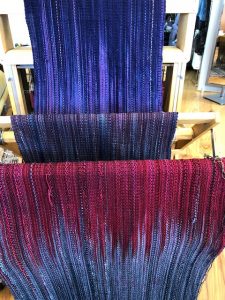
Thickset yardage made by Jill Altman.
Yards and yards of Plain Thickset XVI. The draft was turned and threaded in a 6 shaft straight draw. Yarns are a mixture of tencel, cotton novelty and cotton/rayon blend. Each two inch repeat uses a repeat of 24 thinner yarns (8/2, 5/2 and 10/2) and 6 thick yarns of approximately 1200-1600 ypp. The warp was handpainted with fiber reactive dyes.
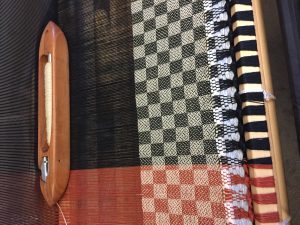
Deception Diaper
Hargrove Draft 52: After a lot of reading and research, I realized that the draft was really a broken twill, block weave. So then I looked in Carol Strickler’s Book: A Weaver’s Book of 8 Shaft Patterns, and found the #247 draft by Judy Steinkoenig closely resembled the Hargrove draft and also the version Jennifer deJung produced when the Hargrove study was done previously. With Beryl’s help, I got this result. And just so you know, the color scheme is only because I was running out of black! But I like it!
Shelley Neate
And if you’re ready to start a new group, take a look at the guidelines below and email Joan Near (nearfiberarts@gmail.com) to get started!
Media